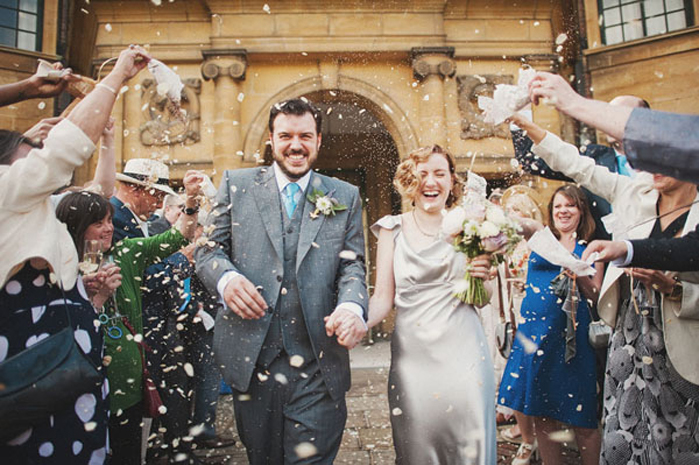We all know how many traditions can go into a wedding if you want them there. But how many of these traditions do you actually know about the origins of? Do you know why you’re having bridesmaids or the purpose of your wedding veil? Here are our top ten wedding traditions explained.
Stag party/hen party traditions
The stag party, or bachelor party originates from ancient Roman times, when the Spartan soldiers held a dinner for their friend’s – the groom – honour. It was a celebration of his last night as a single man. The hen, or bachelorette party eventually spawned from this years later. In contrast, the bridal shower came from very different origins. Although not a common tradition here in Ireland, the idea came from the days of dowries, when friends and family would ‘shower’ the bride-to-be with gifts to make up a suitable dowry if she didn’t have one herself.
Bridesmaids
As helpful as your bridesmaids will be to you in the run up to your wedding day, be thankful they don’t have the role they once did. The original reason for bridesmaids was actually to protect the bride from evil spirits. Bridesmaids once had to dress similar to the bride and accompany the bride everywhere to ‘confuse’ evil spirits and prevent them from getting at the bride.
Wearing white
While you might be aware that the colour white (or a version of it) represents purity for your wedding day, you might not know where the white wedding dress started. Historically, a bride would wear the most expensive dress she had for her day, while colour-wise blue was the popular choice, which represented purity at the time. However, Queen Victoria single-handedly kicked off the trend of white wedding dresses for the next 150 years when she wore hers in 1840. Even though colourful dresses are becoming a popular trend with some brides even going back to blue, Queen Victoria’s influence is still going strong.
Wearing a veil
Wearing a wedding veil goes back to Roman times and symbolised a bride’s modesty and purity. The veil was also thought to protect the bride against demons and witches similar to the bridesmaids. The veil was thought to hide the bride from sight so that she couldn’t be cursed.
Old, new, borrowed and blue
This popular superstition dates back to Victorian times. We know it brings good luck, but what exactly does it mean? Your something old represents your past, while the something new represents your future happiness with your new husband. Traditionally you should borrow something from someone who is happily married in the hope that they’re good luck in marriage will rub off on you and your something blue simply represents fidelity, purity and love. If you're looking for ideas for your something blue, we have plenty. The additional line to the rhyme, ‘a sixpence in your shoe’ is largely British, and represents good fortune and prosperity.
Not seeing each other
While some couples are already doing away with this tradition in favour of first look photo shoots, the tradition actually dates back to the days of arranged marriages. The bride and groom would only meet for the first time at the wedding to prevent the groom from deciding to do a runner before the wedding if he didn’t like the look of his bride – charming!
Giving the bride away
Most people will be familiar with this tradition from a similar time of arranged marriages when the father basically sold the bride to the groom, and the ‘giving away’ was pretty literal. Many brides nowadays choose to skip this tradition completely because the origins and connotations of being considered property. However, as with many traditions, the original meaning has become obsolete and it can be a very touching moment for the father of the bride.
Throwing rice
Another one of many traditions from the Romans, showering the newlyweds with wheat was believed to symbolise fertility and help the couple have children. This was swapped with rice in The Middle Ages, which also represented fruitfulness. For years, throwing rice was thought to be a bad because birds and other animals would eat it and get sick, but this has since been disproven. However, many venues and churches still prefer you not to throw rice because the grains of rice can cause guests to slip!
Throwing the bouquet
This is definitely one of the strangest traditions in terms of its origins. In the 14th century, it was considered good luck for guests to tear off a piece of the bride’s dress. So much of a good luck charm was it, that the guests would even chase the bride to forcibly tear off a piece of the dress, and the bride wasn’t always left in the best of shape. Thankfully the dresses weren’t the exquisite beauties that they are now. For brides that wanted to distract the luck-hungry crowd, and as the actual dress-tearing became less popular, the bride would throw her bouquet or her garter instead.
Tying cans to the car
Not always done anymore, but another one of many traditions that were once used to keep evil spirits at bay. It was said that the noise the tin cans made would ward off evil spirits. If you’re familiar with an even older tradition of shoes as well as cans being tied to the back of the car, then this supposedly came from Ancient Egypt when the father of the bride would give the groom his daughter’s sandal to mark the ‘exchange’. Shoes were also considered a sign of fertility.
- Jenny Darmody
Image credits: Confetti: Ed Peers Photography via Snippet & Ink | Hen party: Wedding Chicks | Bridesmaids: Pinterest | Bride: Pinterest | Veil: Percy Handmade| Pin: Pinterest | First look: Style Me Pretty | Bouquet: Lexia Frank Photography via Elizabeth Anne Designs | Rice throw: Pinterest


